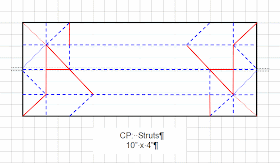Here is a box which began life as an attempt to follow someone's verbal instructions for making a vase. I never did figure it out but was satisfied with the box which I created along the way. Since I began the experiment several days ago, it has been through several variations and ended up with a couple of lids .
The yellow box is version three. It begins life as a square which is pre-folded into quarters. The outside eighth is divided into thirds by the simple expedient of folding the edge in towards the next crease until it looks to be about half way. It is reasonably accurate, if you are careful to check the corners to see that the edges line up.


Version four is folded from a square which has been pre-creased into thirds. In one of the early blogs on this site you will find the URL for a convenient division helper template. It uses the parallel lines trick.
The nice thing about the thirds version is that corner ends which are tucked in around the box in a clockwise direction are lined up well enough to give the impression that the edging is braided all the way around. It is, in fact, an illusion.
Once the sides have been rolled over and the end strips formed, collapse the model into a preliminary base. This will push up the overlapped ends until they form a long point. These points will be tucked into the adjoining side in a clockwise direction.
The slanted sides of the box are found by lining the base of the V on the pointed corner end strip with the middle crease on the side panel. Line up the V and push the piece flat to form a slanted side. You can minimize the creasing by rolling the stip a little before bending it. The wall crease should begin from the pre-crease line below it. In the thirds version you will not need to fold the base up after forming the wall slants as the edge coincides exactly with this pre-creases. However, a little bit of extra creasing at this point helps the final assembly stage.
Unfold the creased flap and move to the next side.
Once all four sides have been creased go around the model again, tucking in each end strip and creasing the tips in line with the slanting crease from the next side panel. Un-tuck and proceed to the next section.
Once this has been done tuck the ends in all the way around and leave them there. The last strip will have to eased over the bend of the adjoining wall.
Finally flatten the floor, firm up the base of the box and gently push the tucked-in strips up as far as they will go. {They slip down a little during construction.}


The first lid is very easy to fold. It is basically a variant of the windmill base. The top square is a little larger than the top entry of the box. In order to lock the box the corner tips (yes, them again) are folded under the lid and then folded back on themselves. I estimate this distance and you can too. Just make sure that the line is parallel.
Finally, put the lid on top of the box and tuck the tips into the corner pockets around the top of the box.
The second lid is almost identical except for the addition of a halving fold which allow the underside of the paper to be seen.
Emjoy!



















































